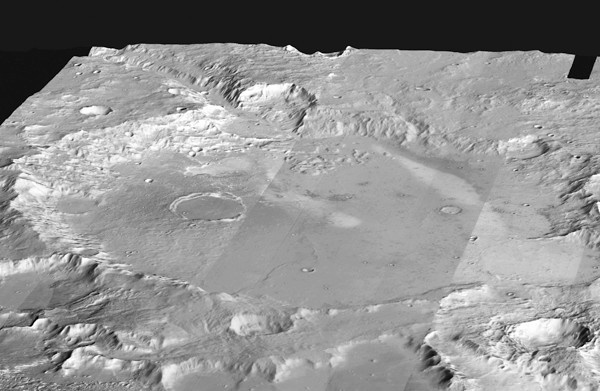
by Timothy Oleson Monday, June 23, 2014

An ancient river channel can be seen entering Gusev Crater on Mars in the upper left of this photo mosaic. Credit: NASA/JPL/Arizona State University.
Scientists have speculated that billions of years ago Mars had a much thicker atmosphere, which warmed the surface enough to maintain large amounts of liquid water. To test that idea, researchers used data from MRO to analyze hundreds of impact craters, formed at about the same time as rocky deposits and features left behind by flowing water, in the roughly 3.6-billion-year-old Aeolis Dorsa region of Mars (near where Curiosity is currently exploring). Because incoming asteroids and meteorites are ablated, or eroded, by atmospheric friction, the thicker an atmosphere, the larger the minimum-size impactor able to reach the surface will be — and hence, the larger the minimum-size crater created will be. Based on the minimum size of the preserved craters observed, Edwin Kite of Caltech and colleagues reported in Nature Geoscience that Mars' long-term average atmospheric pressure back then was, at most, 1 to 2 bars. This is similar to the average atmospheric pressure at Earth’s surface today (roughly 1 bar), but far lower than levels thought to be necessary to keep water from freezing billions of years ago on Mars. In a commentary also in Nature Geoscience, Sanjoy M. Som of the Blue Marble Space Institute of Science and NASA Ames wrote that the researchers “effectively rule out a long-lasting thick atmosphere.” But it is still possible, he wrote, “that transient intervals of dense atmosphere periodically permitted liquid water to flow.”
When NASA’s Spirit rover was studying Gusev Crater from 2004 to 2010, scientists expected to find evidence in the rock there of an ancient crater lake. Instead, they saw basalt, tephra and small amounts of carbonate minerals — the latter interpreted to have been formed by hydrothermal waters — all evidence of volcanic activity, but not a lake. But after reexamining the data, Steven Ruff of Arizona State University and colleagues have reported in Geology that the carbonate minerals were indeed formed by low-temperature, rather than hot hydrothermal, fluids. This probably occurred, they suggested, when floodwaters intermittently entered the crater, dissolved the tephras and subsequently evaporated, leaving behind the carbonates.
Astronomers routinely observe asteroids from Earth, but for the first time, they have gotten a view of some of these rocky bodies from another planet. On April 20, the Curiosity rover snapped a photo with its Mast Camera that captured the asteroids Ceres and Vesta — two of the three largest in the asteroid belt between Mars and Jupiter — along with one of Mars' two moons, Deimos, as they passed by overhead in the night sky. The photo was taken as “part of an experiment checking the opacity of the [Martian] atmosphere at night,” MastCam scientist Mark Lemmon of Texas A&M University said in a statement.
© 2008-2021. All rights reserved. Any copying, redistribution or retransmission of any of the contents of this service without the expressed written permission of the American Geosciences Institute is expressly prohibited. Click here for all copyright requests.